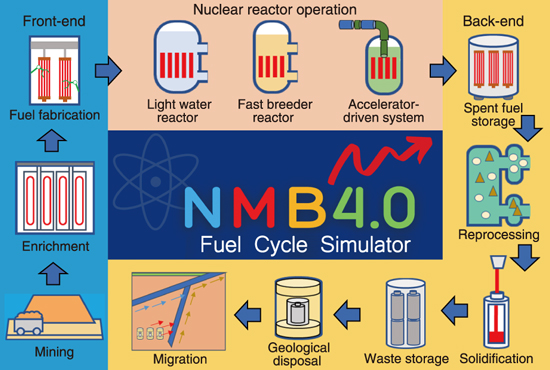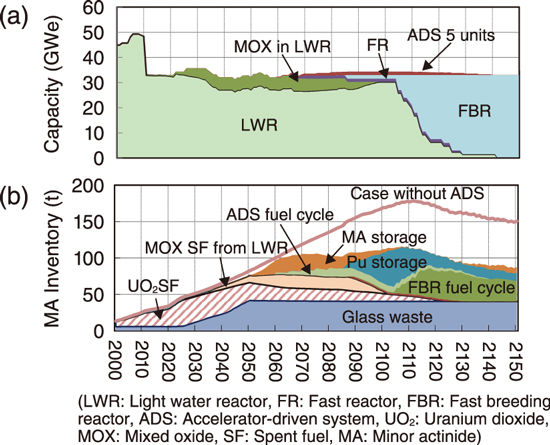
Fig.4-10 Nuclear fuel cycle simulated by NMB4.0

Fig.4-11 Example of NMB4.0 analysis
Japan is currently developing various reactor types (fast reactors, light water reactors, small reactors, etc.) and reprocessing technologies to reduce the burden of waste disposal for future nuclear energy use. To commence full-scale development for realizing the new technology, it is necessary to clarify the effects of the introduction of such technology on the nuclear power industry. For this purpose, it is necessary to evaluate the advantages and disadvantages of the technology by clarifying the amount of nuclear fuel and waste to be handled in the nuclear fuel cycle and the scale of facilities required to handle them, as shown in Fig.4-10, assuming the timing and scale of the introduction of the new technology. A program called “nuclear fuel cycle simulator” is used for such evaluations. So far, no general-purpose simulator has been made publicly available in Japan, and many excellent simulators in other countries are not available to the public. However, to fairly evaluate new technologies such as those for reactor development, which is being undertaken by various organizations, it is essential to analyze these technologies using common scenarios and simulators. The inaccessibility of such simulators to the public has been a major obstacle. Therefore, the JAEA and Tokyo Institute of Technology (Tokyo Tech) jointly developed NMB4.0, a fast, versatile, and flexible simulator, and released it on the Tokyo Tech website (https://nmb-code.jp) in March 2022. NMB stands for Nuclear Material Balance. This simulator has the following features.
Speed: Conventional simulators have mostly calculated burnup changes in nuclear reactors for about 20–30 nuclear materials such as uranium and plutonium. However, to accurately evaluate the generation and disposal of radioactive waste, the NMB has the ability to calculate about 150 fission products produced by the fission of uranium. We successfully developed a solution method for solving the burnup equation with high speed and sufficient accuracy so that calculations requiring several hours with the conventional solution methods can be completed within a few minutes.
Versatility: NMB can analyze almost all the processes involved in nuclear power generation (Fig.4-10). For nuclear reactors, the database has been developed to allow analysis of not only light water reactors, which are the main type of modern reactors, but also futuristic reactors such as sodium-cooled fast reactors, gas-cooled reactors, and accelerator-driven systems.
For the nuclear fuel cycle, we created a sufficiently accurate temperature calculation model and a substantial database for the geological disposal of radioactive waste, which is often not included in other simulators. For geological disposal, the rise in temperature of the repository must be considered when calculating the repository size, but this factor is not evaluated in many codes. NMB has a database that can evaluate the temperature of the geological repository design being considered in Japan, thus allowing the size of the repository to be evaluated within the code.
Flexibility: The future of nuclear power utilization in Japan is very vague because of uncertainties in the replacement of light water reactors, delays in the development of fast reactors, and difficulties in selecting a geological disposal site. Therefore, we designed the simulator to analyze a variety of scenarios, such as withdrawal or continuation of nuclear power use and changes in the timing of FBR introduction. (Analysis example: Fig.4-11) Furthermore, to adapt to various situations, the parameters are described by models without being fixed. For example, we created models to evaluate the amount of plutonium in fresh fuel for fast reactors or the amount of radioactive materials involved in the vitrification of radioactive waste, depending on the composition of the materials without predetermining them.
We openly invite users and developers to utilize NMB. We expect the users to include universities, research institutes, manufacturers, and electric power utilities, and hope that NMB will be useful in the research and development of future nuclear reactors and nuclear fuel cycle technologies and in planning implementation strategies for sustainable nuclear energy use. Furthermore, we would like to foster a community centered on NMB, continue to develop it to enhance evaluation functions such as economic efficiency and environmental impact, and fulfill the role of a research platform to realize evaluation researches across energy fields, including other power sources.
This research includes the results of a joint research project with Tokyo Tech (FY2021) entitled “Study on partitioning of radionuclides in spent fuel reprocessing and evaluation of various quantities in advanced nuclear fuel cycle”.
(Kenji Nishihara)